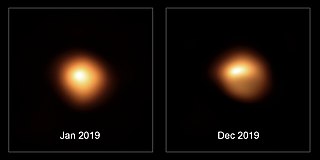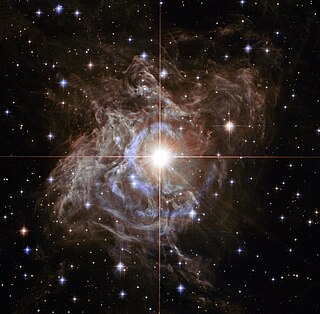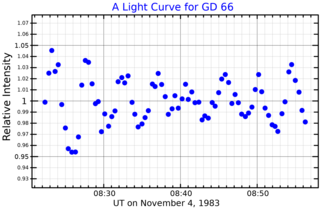
A variable star is a star whose brightness as seen from Earth changes with time. This variation may be caused by a change in emitted light or by something partly blocking the light, so variable stars are classified as either:

A Cepheid variable is a type of variable star that pulsates radially, varying in both diameter and temperature. It changes in brightness, with a well-defined stable period and amplitude.

BPM 37093 is a variable white dwarf star of the DAV, or ZZ Ceti, type, with a hydrogen atmosphere and an unusually high mass of approximately 1.1 times the Sun's. It is 48 light-years from Earth in the constellation Centaurus and vibrates; these pulsations cause its luminosity to vary. Like other white dwarfs, BPM 37093 is thought to be composed primarily of carbon and oxygen, which are created by thermonuclear fusion of helium nuclei in the triple-alpha process.
PSR B1257+12, previously designated PSR 1257+12, alternatively designated PSR J1300+1240, is a millisecond pulsar located 2,300 light-years from the Sun in the constellation of Virgo, rotating at about 161 times per second. It is also named Lich, after a powerful, fictional undead creature of the same name.

HR Lyrae or Nova Lyrae 1919 was a nova which occurred in the constellation Lyra in 1919. Its discovery was announced by Johanna C. Mackie on 6 December 1919. She discovered it while examining photographic plates taken at the Harvard College Observatory. The bulletin announcing the discovery states "Between December 4 and 6 it rose rapidly from the sixteenth magnitude or fainter, to a maximum of about 6.5". It was the first nova ever reported in Lyra, and Mackie was awarded the AAVSO gold medal for her discovery. Its peak magnitude of 6.5 implies that it might have been visible to the naked eye, under ideal conditions.

Giclas 29-38, also known as ZZ Piscium, is a variable white dwarf star of the DAV type, whose variability is due to large-amplitude, non-radial pulsations known as gravity waves. It was first reported to be variable by Shulov and Kopatskaya in 1974. DAV stars are like normal white dwarfs but have luminosity variations with amplitudes as high as 30%, arising from a superposition of vibrational modes with periods from 100 to 1,000 seconds. Large-amplitude DAVs generally differ from lower-amplitude DAVs by having lower temperatures, longer primary periodicities, and many peaks in their vibrational spectra with frequencies which are sums of other vibrational modes.

IK Pegasi is a binary star system in the constellation Pegasus. It is just luminous enough to be seen with the unaided eye, at a distance of about 154 light years from the Solar System.

HL Tau 76 is a variable white dwarf star of the DAV type. It was observed by G. Haro and W. J. Luyten in 1961, and was the first variable white dwarf discovered when, in 1968, Arlo U. Landolt found that it varied in brightness with a period of approximately 749.5 seconds, or 12.5 minutes. Like other DAV white dwarfs, its variability arises from non-radial gravity wave pulsations within itself., § 7. Later observation and analysis has found HL Tau 76 to pulsate in over 40 independent vibrational modes, with periods between 380 seconds and 1390 seconds.
A pulsating white dwarf is a white dwarf star whose luminosity varies due to non-radial gravity wave pulsations within itself. Known types of pulsating white dwarfs include DAV, or ZZ Ceti, stars, with hydrogen-dominated atmospheres and the spectral type DA; DBV, or V777 Her, stars, with helium-dominated atmospheres and the spectral type DB; and GW Vir stars, with atmospheres dominated by helium, carbon, and oxygen, and the spectral type PG 1159. GW Vir stars may be subdivided into DOV and PNNV stars; they are not, strictly speaking, white dwarfs but pre-white dwarfs which have not yet reached the white dwarf region on the Hertzsprung-Russell diagram. A subtype of DQV stars, with carbon-dominated atmospheres, has also been proposed, and in May 2012, the first extremely low mass variable (ELMV) white dwarf was reported.

Ross 548 is a white dwarf in the equatorial constellation of Cetus. With a mean apparent visual magnitude of 14.2 it is much too faint to be visible to the naked eye. Based on parallax measurements, it is located at a distance of 107 light years from the Sun. It was found to be variable in 1970 and in 1972 it was given the variable star designation ZZ Ceti. This is a pulsating white dwarf of the DAV type that is the prototype of the ZZ Ceti variable class., pp. 891, 895.

PG 1159-035 is the prototypical PG 1159 star after which the class of PG 1159 stars was named. It was discovered in the Palomar-Green survey of ultraviolet-excess stellar objects and, like the other PG 1159 stars, is in transition between being the central star of a planetary nebula and being a white dwarf.

GD 358 is a variable white dwarf star of the DBV type. Like other pulsating white dwarfs, its variability arises from non-radial gravity wave pulsations within the star itself. GD 358 was discovered during the 1958–1970 Lowell Observatory survey for high proper motion stars in the Northern Hemisphere. Although it did not have high proper motion, it was noticed that it was a very blue star, and hence might be a white dwarf. Greenstein confirmed this in 1969.

Roy Edward Nather was an American astronomer, who at the time of his death, was professor emeritus in Astronomy at University of Texas at Austin. He pioneered the fields of asteroseismology of white dwarfs, and observational studies of interacting binary collapsed stars.

GD 66 or V361 Aurigae is a 0.64 solar mass (M☉) pulsating white dwarf star located 170 light years from Earth in the Auriga constellation. The estimated cooling age of the white dwarf is 500 million years. Models of the relationship between the initial mass of a star and its final mass as a white dwarf star suggest that when the star was on the main sequence it had a mass of approximately 2.5 M☉, which implies its lifetime was around 830 million years. The total age of the star is thus estimated to be in the range 1.2 to 1.7 billion years.
V391 Pegasi b, also known as HS 2201+2610 b, is an extrasolar planet candidate orbiting the star V391 Pegasi approximately 4,570 light-years away in the constellation of Pegasus. The candidate planet was discovered by means of variable star timing, which measured anomalies in variability of the star caused by a planet. It is the first planet candidate to claim to be detected with this method. The discovery reported the planet candidate to have mass of 3.2 times Jupiter's, semi-major axis of 1.7 AU, and orbital period of 1,170 days.

A B-type subdwarf (sdB) is a kind of subdwarf star with spectral type B. They differ from the typical subdwarf by being much hotter and brighter. They are situated at the "extreme horizontal branch" of the Hertzsprung–Russell diagram. Masses of these stars are around 0.5 solar masses, and they contain only about 1% hydrogen, with the rest being helium. Their radius is from 0.15 to 0.25 solar radii, and their temperature is from 20,000 to 40,000 K.

AN Ursae Majoris is a binary star system in the northern circumpolar constellation of Ursa Major. It is a variable star, with AN Ursae Majoris being the variable star designation, and ranges in brightness from 14.90 down to 20.2. Even at its peak brightness though, the system is much too faint to be visible to the naked eye. Based on parallax measurements, the system is located roughly 1,050 light years away from the Sun.

RR Telescopii is a symbiotic nova in the southern constellation Telescopium. It was recorded on photographic survey plates as a faint variable star between photographic magnitude (mpg) 9 to 16.6 from 1889 to 1944. In late 1944 the star began to brighten, increasing by about 7 magnitudes, from mpg ≈ 14 to brighter than 8. Brightening continued with a diminished rate of increase after early 1945, but the overall outburst was not noted until the star was seen at about 6.0, the threshold of naked eye brightness, in July 1948. At that time it was given the designation Nova Telescopii 1948. Since mid-1949 it has declined in brightness slowly, albeit accompanied by some remarkable changes in its spectrum, and as of August 2013 it had faded to visual magnitude around 12.
Don E. Winget is an American astronomer and astrophysicist who studies white dwarf stars. He is the Harlan J. Smith Centennial Professor in Astronomy and a university distinguished teaching professor at the University of Texas at Austin.

FG Virginis is a well-studied variable star in the equatorial constellation of Virgo. It is a dim star, near the lower limit of visibility to the naked eye, with an apparent visual magnitude that ranges from 6.53 down to 6.58. The star is located at a distance of 273.5 light years from the Sun based on parallax measurements, and is drifting further away with a radial velocity of +16 km/s. Because of its position near the ecliptic, it is subject to lunar occultations.

















